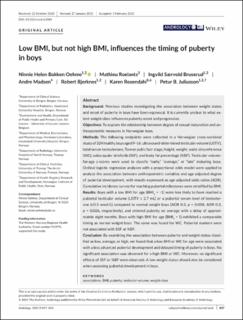| dc.contributor.author | Oehme, Ninnie Helen Bakken | |
| dc.contributor.author | Roelants, Mathieu | |
| dc.contributor.author | Bruserud, Ingvild Særvold | |
| dc.contributor.author | Madsen, Andre | |
| dc.contributor.author | Bjerknes, Robert | |
| dc.contributor.author | Rosendahl, Karen | |
| dc.contributor.author | Juliusson, Pétur Benedikt | |
| dc.date.accessioned | 2021-08-13T11:14:16Z | |
| dc.date.available | 2021-08-13T11:14:16Z | |
| dc.date.created | 2021-03-12T12:53:02Z | |
| dc.date.issued | 2021 | |
| dc.identifier.issn | 2047-2919 | |
| dc.identifier.uri | https://hdl.handle.net/11250/2767768 | |
| dc.description.abstract | Background
Previous studies investigating the association between weight status and onset of puberty in boys have been equivocal. It is currently unclear to what extent weight class influences puberty onset and progression.
Objectives
To explore the relationship between degree of sexual maturation and anthropometric measures in Norwegian boys.
Methods
The following endpoints were collected in a Norwegian cross-sectional study of 324 healthy boys aged 9–16: ultrasound-determined testicular volume (USTV), total serum testosterone, Tanner pubic hair stage, height, weight, waist circumference (WC), subscapular skinfolds (SSF), and body fat percentage (%BF). Testicular volume-for-age z-scores were used to classify “early,” “average,” or “late” maturing boys. Ordinal logistic regression analyses with a proportional odds model were applied to analyze the association between anthropometric variables and age-adjusted degree of pubertal development, with results expressed as age-adjusted odds ratios (AOR). Cumulative incidence curves for reaching pubertal milestones were stratified by BMI.
Results
Boys with a low BMI for age (BMIz < −1) were less likely to have reached a pubertal testicular volume (USTV ≥ 2.7 mL) or a pubertal serum level of testosterone (≥0.5 nmol/L) compared to normal weight boys (AOR 0.3, p = 0.038, AOR 0.3, p = 0.026, respectively), and entered puberty on average with a delay of approximately eight months. Boys with high BMI for age (BMIz > 1) exhibited a comparable timing as normal weight boys. The same was found for WC. Pubertal markers were not associated with SSF or %BF.
Conclusion
By examining the association between puberty and weight status classified as low, average, or high, we found that a low BMI or WC for age were associated with a less advanced pubertal development and delayed timing of puberty in boys. No significant association was observed for a high BMI or WC. Moreover, no significant effects of SSF or %BF were observed. A low weight status should also be considered when assessing pubertal development in boys. | en_US |
| dc.language.iso | eng | en_US |
| dc.publisher | Wiley | en_US |
| dc.rights | Navngivelse 4.0 Internasjonal | * |
| dc.rights.uri | http://creativecommons.org/licenses/by/4.0/deed.no | * |
| dc.title | Low BMI, but not high BMI, influences the timing of puberty in boys | en_US |
| dc.type | Journal article | en_US |
| dc.type | Peer reviewed | en_US |
| dc.description.version | publishedVersion | en_US |
| dc.rights.holder | Copyright 2021 The Authors | en_US |
| cristin.ispublished | true | |
| cristin.fulltext | original | |
| cristin.qualitycode | 1 | |
| dc.identifier.doi | 10.1111/andr.12985 | |
| dc.identifier.cristin | 1897651 | |
| dc.source.journal | Andrology | en_US |
| dc.source.pagenumber | 837-845 | en_US |
| dc.relation.project | Helse Vest RHF: 911975 | en_US |
| dc.identifier.citation | Andrology. 2021, 9 (3), 837-845. | en_US |
| dc.source.volume | 9 | en_US |
| dc.source.issue | 3 | en_US |

